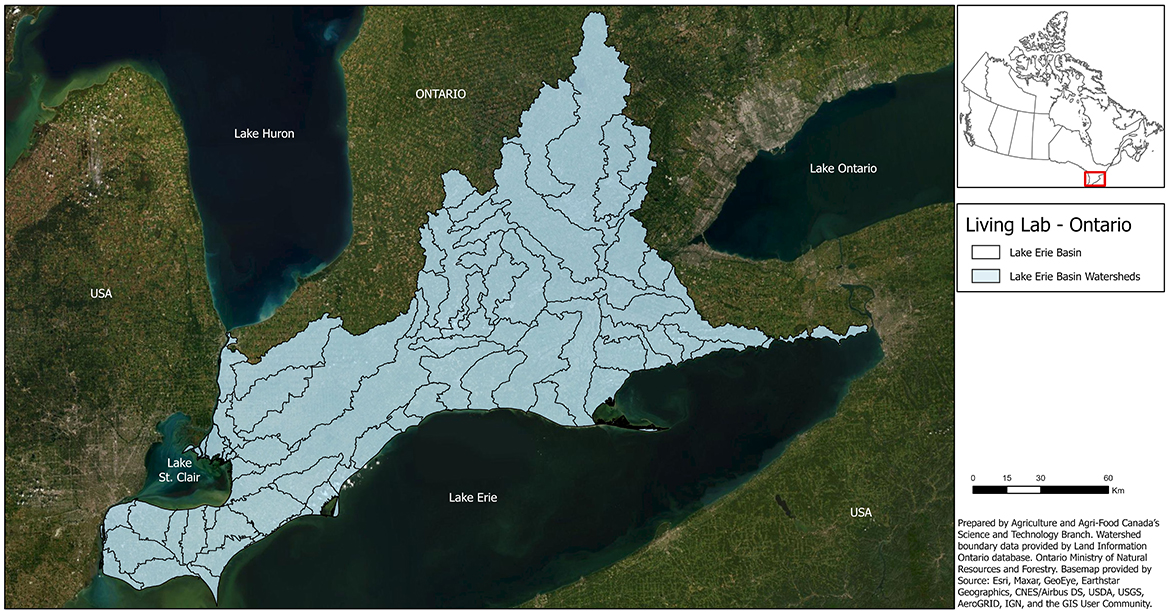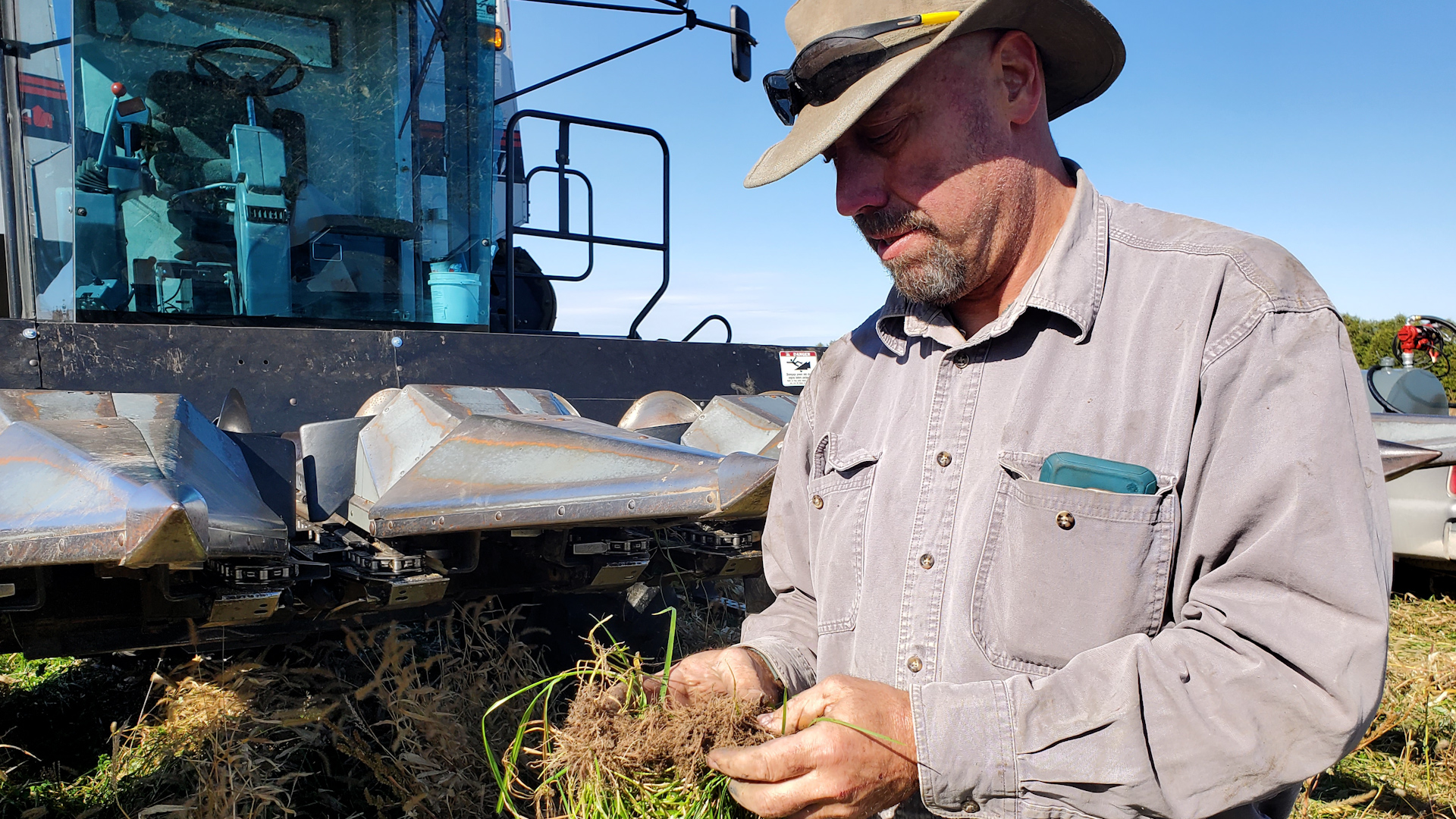Living Lab – Ontario is located in the Lake Erie basin, which is in the southwestern region of the province. On-farm research will be conducted at multiple locations on landscapes that reflect the varied geography and agricultural production in the Lake Erie basin. Research will also be conducted in watersheds in the upper and lower portions of the basin.

Description of above image
A satellite image of southwestern Ontario highlighting the land in Canada that drains into Lake Erie and Lake St. Clair, referred to as the (Canadian) Lake Erie basin. The smaller outlined areas are the sixty-five quaternary subwatersheds that make up the Lake Erie basin. Prepared by Agriculture and Agri-Food Canada’s Science and Technology Branch. Watershed boundary data provided by Land Information Ontario Database. Ontario Ministry of Natural Resources and Forestry. Basemap provided by Earthstar Geomatics.
The Great Lakes hold approximately 20% of the world’s freshwater, which is used for drinking, irrigation, fishing and recreation by more than 40 million Canadians and Americans. Lake Erie is the smallest and shallowest of the Great Lakes, making it the most sensitive to the effects of nutrients, such as phosphorus, from human activity. Due to its warm climate and fertile soils, about 75% of the land in the Canadian Lake Erie basin is used for agriculture. The climate, soils, landscape and agriculture in the Lake Erie basin are diverse. Gentle rolling hills in the upper basin support a mix of cash crop and livestock production. Flat clay plains in the lower basin support extensive cash crop and vegetable production. Sand plains in the south-central part of the basin support fruit and vegetable production and high-value speciality crops, such as ginseng. Reducing the contribution of agricultural sources of nutrients, especially phosphorus, to Lake Erie is an international, national and provincial priority.
The importance of reducing the loss of agricultural nutrients and soil from agricultural landscapes into Lake Erie was discussed during the Living Lab – Ontario engagement sessions in 2018 and early 2019. Since soil and water quality are interrelated and vital for agricultural sustainability, farmers and local collaborators identified four agri-environmental priorities:
- Soil quality
- Water quality
- Watershed management
- Biodiversity
Living Lab – Ontario will focus on developing and testing farming practices and technologies on working farms to address these priority issues.
Collaborators
- Agriculture and Agri-Food Canada
- Ontario farmers
- Ontario Soil and Crop Improvement Association (Lead collaborator)
- Ecological Farmers Association of Ontario
- Environment and Climate Change Canada
- Essex Region Conservation Authority
- Innovative Farmers Association of Ontario
- Lower Thames Valley Conservation Authority
- Ontario Soil Network
- Upper Thames River Conservation Authority
Activities
Innovative on-farm trials
The objective is to measure crop production and environmental impacts of various farm management strategies to achieve continuous cover crops and/or minimum tillage.
Lead collaborator or Agriculture and Agri-Food Canada activities:
- Establish innovative on-farm trials to achieve continuous cover crops and minimum tillage in diverse agricultural production systems and landscape types
- Evaluate the benefits of incorporating best farming practices on soil health, water quality and resilience to impacts of climate change
Watershed management
The objective is to measure the distribution and impact of continuous cover crops and / or minimum tillage on a watershed-wide basis.
Lead collaborator or Agriculture and Agri-Food Canada activities:
- Conduct monitoring and modelling studies to measure the impact of best farming practice implementation on nutrient cycling and aquatic health on a watershed-wide basis
- Determine the extent of cover crop adoption on a watershed-wide basis using remote sensing technology
Socio-economic studies
The objective is to support and understand farmer decision-making to adopt continuous cover and minimum tillage.
Lead collaborator or Agriculture and Agri-Food Canada activities:
- Conduct financial, economic and social studies at both individual farm and Lake Erie-basin scales
- Identify costs, benefits and barriers to implementing new practices by farmers
Engagement, education and outreach
The objective is to undertake engagement, education and outreach activities to increase the adoption of new farming practices.
Lead collaborator or Agriculture and Agri-Food Canada activities:
- Communicate the environmental and economic benefits of new practices to the farming community
- Use a variety of traditional and innovative methods to transfer knowledge, including demonstrations, workshops, videos and peer-to-peer learning opportunities
Video

Living Lab – Ontario video
Collaborating towards sustainable farming